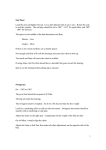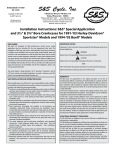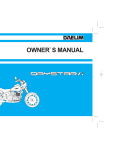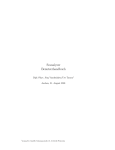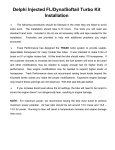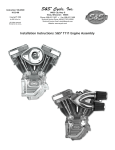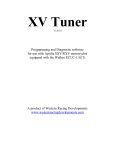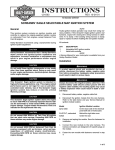Download - S&S Cycle
Transcript
S&S Cycle, Inc ® Instruction 51-1156 03-25-10 Copyright©2003,2006,2010 byS&S®Cycle,Inc. . 14025 Cty Hwy G PO Box 215 Viola, Wisconsin 54664 Phone:608-627-1497 • Fax:608-627-1488 Allrightsreserved. PrintedintheU.S.A. Technical Service Phone: 608-627-TECH (8324) Technical Service Email: [email protected] Website: www.sscycle.com Installation Instructions: S&S® IST Ignition System for 1984-1999 Big Twin and Custom Applications DISCLAIMER: S&S parts are designed for high performance, closed course, racing applications and are intended for the very experienced rider only. The installationofS&Spartsmayvoidoradverselyaffectyourfactorywarranty. Inadditionsuchinstallationandusemayviolatecertainfederal,state,and locallaws,rulesandordinancesaswellasotherlawswhenusedonmotor vehiclesusedonpublichighways,especiallyinstateswherepollutionlaws mayapply.Alwayscheckfederal,state,andlocallawsbeforemodifyingyour motorcycle.Itisthesoleandexclusiveresponsibilityoftheusertodetermine thesuitabilityoftheproductforhisorheruse,andtheusershallassumeall legal,personalinjuryriskandliabilityandallotherobligations,duties,and risksassociatedtherewith. The words Harley®, Harley-Davidson®, H-D®, Sportster®, Evolution®, and all H-Dpartnumbersandmodeldesignationsareusedinreferenceonly.S&S CycleisnotassociatedwithHarley-Davidson,Inc. IMPORTANT NOTICE: Statementsinthisinstructionsheetprecededbythefollowingwordsareof specialsignificance. WARNING Meansthereisthepossibilityofinjurytoyourselforothers. CAUTION Meansthereisthepossibilityofdamagetothepartormotorcycle. NOTE Other information of particular importance has been placed in italic type. S&S recommends you take special notice of these items. WARRANTY: SAFE INSTALLATION AND OPERATION RULES: BeforeinstallingyournewS&Spartitisyourresponsibilitytoreadandfollow theinstallationandmaintenanceproceduresintheseinstructionsandfollow thebasicrulesbelowforyourpersonalsafety. Gasolineisextremelyflammableandexplosiveundercertainconditions andtoxicwhenbreathed.Donotsmoke.Performinstallationinawell ventilatedareaawayfromopenflamesorsparks. If motorcycle has been running, wait until engine and exhaust pipes have cooled down to avoid getting burned before performing any installationsteps. Beforeperforminganyinstallationstepsdisconnectbatterytoeliminate potentialsparksandinadvertentengagementofstarterwhileworking onelectricalcomponents. Read instructions thoroughly and carefully so all procedures are completely understood before performing any installation steps. ContactS&Swithanyquestionsyoumayhaveifanystepsareunclearor anyabnormalitiesoccurduringinstallationoroperationofmotorcycle withaS&Spartonit. Consultanappropriateservicemanualforyourmotorcycleforcorrect disassemblyandreassemblyproceduresforanypartsthatneedtobe removedtofacilitateinstallation. Use good judgment when performing installation and operating motorcycle.Goodjudgmentbeginswithaclearhead.Don’tletalcohol, drugsorfatigueimpairyourjudgment.Startinstallationwhenyouare fresh. Besureallfederal,stateandlocallawsareobeyedwiththeinstallation. For optimum performance and safety and to minimize potential damagetocarborothercomponents,useallmountinghardwarethatis providedandfollowallinstallationinstructions. Motorcycle exhaust fumes are toxic and poisonous and must not be breathed. Run motorcycle in a well ventilated area where fumes can dissipate. • • • • • • • • • All S&S parts are guaranteed to the original purchaser to be free of manufacturingdefectsinmaterialsandworkmanshipforaperiodoftwelve (12)monthsfromthedateofpurchase.Merchandisethatfailstoconformto theseconditionswillberepairedorreplacedatS&S’soptionifthepartsare returnedtousbythepurchaserwithinthe12monthwarrantyperiodorwithin 10daysthereafter. Intheeventwarrantyserviceisrequired,theoriginalpurchasermustcallor writeS&Simmediatelywiththeproblem.Someproblemscanberectifiedbya telephonecallandneednofurthercourseofaction. A part that is suspect of being defective must not be replaced by a Dealer without prior authorization from S&S. If it is deemed necessary for S&S to make an evaluation to determine whether the part was defective, a return authorizationnumbermustbeobtainedfromS&S.Thepartsmustbepackaged properlysoastonotcausefurtherdamageandbereturnedprepaidtoS&S withacopyoftheoriginalinvoiceofpurchaseandadetailedletteroutlining thenatureoftheproblem,howthepartwasusedandthecircumstancesat thetimeoffailure.IfafteranevaluationhasbeenmadebyS&Sandthepart wasfoundtobedefective,repair,replacementorrefundwillbegranted. ADDITIONAL WARRANTY PROVISIONS: (1)S&SshallhavenoobligationintheeventanS&Spartismodifiedbyany otherpersonororganization. (2)S&SshallhavenoobligationifanS&Spartbecomesdefectiveinwholeorin partasaresultofimproperinstallation,impropermaintenance,improperuse, abnormaloperation,oranyothermisuseormistreatmentoftheS&Spart. (3) S&S shall not be liable for any consequential or incidental damages resulting from the failure of an S&S part, the breach of any warranties, the failuretodeliver,delayindelivery,deliveryinnon-conformingcondition,or foranyotherbreachofcontractordutybetweenS&Sandacustomer. (4)S&SpartsaredesignedexclusivelyforuseinHarley-Davidson®andother Americanv-twinmotorcycles.S&Sshallhavenowarrantyorliabilityobligation ifanS&Spartisusedinanyotherapplication. Instruction Contents: A. Introduction B. Parts List C. Securing Motorcycle D. Removal of Existing Ignition Module E. S&S® System Installation F. Initial Starting and Operation Procedure G. Basic Troubleshooting H. Advanced Troubleshooting CAUTION Do not use a dual fire coil with the S&S ignition module. This kit will NOT work with vehicles equipped with flat slide carbs, open primaries, and dry clutches. If you want to use IST with these configurations contact S&S, we can help set up IST. A.Introduction T he Intelligent Spark Technology system uses a sophisticated computerized ECU module that integrates data from sensors that other ignition systems are not designed to use. The S&S system makes use of a patent pending cam position sensor, MAP sensor, cylinder head temperature sensor, and an exclusive knock sensor that actually detects detonation or knock while the engine runs. The knock sensor allows the ECU to automatically adjust ignition timing to eliminate knock whenever it occurs. In addition, the system “remembers” the conditions that cause the engine to knock and automatically adjusts ignition timing to prevent it when those conditions reoccur. On the other hand, when conditions allow for increased ignition timing, the system will advance timing as far as possible without causing the engine to knock. In effect, the system “learns” the ignition requirements of a particular engine and writes a custom ignition map for it. This results in optimized power and fuel economy, as well as reduced emissions. I f ignition requirements change, if a lower grade of fuel is introduced, for example, the system will automatically make the necessary ignition timing changes to avoid detonation and possible engine damage. This feature is particularly important in touring applications where the rider sometimes has less control over fuel quality. If a different camshaft is installed, or if cylinder head modifications are made, the S&S Intelligent Spark the ignition timing for the new configuration. Even if major engine modifications are made, such as the installation of a stroker or big bore kit, the system will adjust to the ignition requirements of the engine. Additional features: • Simple installation – installation kits plug into stock wiring harness. • No timing adjustments – the system adjusts timing automatically. • 7000 rpm rev limiter. • Single fire operation – requires two coils or dual coil package. • High output – Automatically maximizes coil output. • Automatic dwell adjust – will optimize current for any coil 0.5 to 3 ohms. • Short circuit and reverse polarity protected. • Diagnostics – scan tool or harness jumper. Dual Fire vs. Single Fire Ignition Systems Two types of ignition systems have been used on Harley-Davidson® motorcycles, either dual fire, or single fire. Dual Fire Dual fire ignitions fire the spark plugs in both cylinders on every stroke, each time the pistons reach the tops of the cylinders. One piston is at the top of the compression stroke, while the other piston is near the top of the exhaust stroke. Dual fire is also known as “wasted spark” because the second spark fires near the top of the exhaust stroke. Dual fire was common for many years because of its simplicity and reliability. Dual fire has a slightly rougher idle than single fire because the “wasted” spark occurred just after the top of the exhaust stroke of the rear cylinder, disrupting the incoming intake charge. Single Fire S ingle fire ignitions fire the spark plugs on every other stroke of the engine, only at the top of the compression stroke. One cylinder fires, then after one crankshaft revolution, the other cylinder fires. A single fire ignition system allows the ignition to reliably transmit more power to the coil during the compression stroke when it is needed most. 2 NOTE: The electronics used in the S&S Ignition System require operation in single fire mode only. The S&S Ignition System cannot be used in dual fire mode. Ignition Coil Identification Dual Fire Coil In addition to the spark plug terminals, an aftermarket dual fire coil will have two wiring terminals: positive, negative. Single Fire Coil In addition to the spark plug terminals, an aftermarket single fire coil will typically have three wiring terminals: A negative terminal for the front cylinder, a common 12v + terminal, and negative terminal for the rear cylinder This is the most common style of single fire coil. ll single fire coils are compatible with the S&S ignition if they have a resistance of 0.5 to 3 ohms. The standard rating for and aftermarket single A fire coil is 3 ohms. Coils with higher resistance will decrease ignition output. The S&S® Ignition system will also support a variety of different ignition coil combinations as long as they are connected for single fire operation, and yield a final resistance of 0.5 to 3 ohms. The ignition is also compatible with dual plug heads using the correct coil configuration. Examples of custom coil/spark plug combinations supported by the S&S ignition: • • • • One coil single fire for single plug heads One coil single fire for dual plug heads. Two coil single fire for single plug heads. Two coil single fire for dual plug heads. Spark Plugs and Plug Wires Spark plugs must be resistor spark plugs (suppression type) of the correct style and heat range for the application. Do not use non-resistor plugs Spark plug wires must be suppression type. Do not use solid metal core plug wires. B. Parts List T he S&S Ignition Installation Kit for 1984-1999 big twin and custom applications (S&S #55-1049 See Picture 1, below left) is intended only for installation of S&S Intelligent Spark Technology (IST) Ignition Module (S&S #55-1013 See Picture 2, below right). S&S Ignition System Installation Kit #55-1049 contains the following items (See Picture 1): • 1984-1999 Wiring Harness Adapter (S&S #55-1021) Item (a) • Cylinder Head Temperature Sensor (S&S #55-1039) Item (b) • M AP Sensor (S&S #55-1037, H-D® #32316-99) & Hardware. Item (e) • Camshaft Position Sensor Assembly (S&S #55-1024). Item (c) • 1984-1999 Coil Harness (S&S #55-1038) Item (f) • Camshaft Position Rotor Assembly (S&S # 55-1034) Item (d) • K nock Sensor Kit (Includes: Knock Sensor, Knock Sensor Mount, & Hardware (S&S #55-1015) Item (g) All reference to Harley-Davidson® part numbers is for identification purposes only. We in no way are implying that any of S&S® Cycle’s products are original equipment parts or that they are equivalent to the corresponding Harley-Davidson® part number shown. S&S® Intelligent Spark Technology ECU Module a c f g e d b Picture 1 Picture 2 3 C. Securing Motorcycle CAUTION Motorcycle must be adequately secured against falling over during the Ignition system installation! Use of tie down straps on both sides of the motorcycle is recommended. WARNING Disconnect negative terminal of battery to eliminate potential sparks and inadvertent engagement of the starter while working on motorcycle. 1. Place motorcycle on a suitable repair stand so that the motorcycle is stable and secure with the rear tire elevated. Place motorcycle in 4th or 5th gear. Remove spark plugs. These steps are necessary so that the rear tire can be used to rotate the engine to place the flywheel timing mark in the engine timing hole. D. Removal of Existing Ignition Components 1. Ignition Module a. L ocate the ignition module installed on your motorcycle. The ignition module can usually be found under the seat, a side cover, or in front of the engine on the frame. See Picture 3, below left. Refer to the service manual for your motorcycle if you have trouble locating it. b. R emove the module mounting hardware and unplug the module See Picture 4, below right. The plug is disconnected by simultaneously pressing the locking tabs on the connector and pulling the two halves away from each other. Save the mounting hardware for installation of the S&S® ignition module. Picture 3 Picture 4 2. Existing Coil and VOES a. I f so equipped, remove the existing dual fire ignition coil. This is usually located on the left side near the upper motor mount, above the engine front rocker box, or to the left of the engine near the seat. Remove or insulate the “+” and module terminals in the existing harness with heat shrink or electrical tape. b. I f so equipped, remove the existing vacuum operated electrical switch (VOES). This is located between the heads. Remove or insulate the terminals and connector in the existing harness with heat shrink or electrical tape. E. S&S System Installation Although it may not be necessary in some cases, removal of the gas tank is recommended for ease of installation of the Engine Temperature Sensor, the Knock Sensor Assembly, the Manifold Absolute Pressure (MAP) Sensor and to allow routing of the wiring harness. An alternative to complete tank removal: Loosen (do not remove) the bolt at the front of the tank and remove the mounting bolt(s) at the rear of the tank. The rear of the tank may then be raised slightly to allow enough room to install these components. CAUTION Clearances are limited at the front of the tank. Use care not to damage any painted surfaces while handling tank. 4 Installing components without removing the fuel tank is a timesaving suggestion only. If there is any reservation on the part of the installing mechanic about performing this installation with the fuel tank in place, refer to the appropriate service manual for correct procedure for removing fuel tank and related components. 1. Cylinder Head Temperature Sensor Installation. Harley-Davidson® Evolution® style engines use a special intake flange bolt with an integral temperature sensor. See Picture 5, below. a. Remove the bolt from the front intake mounting flange. b. Install the Cylinder Head Temperature Sensor and washer in the front head intake mounting flange. c. Tighten to 6-10 ft.-lbs. (standard intake bolt torque). 2. Installation of the Knock Sensor Kit Locate the knock sensor at the top motor mount at the rear cylinder head attachment point. a. Remove rear motor mount bolt from rear cylinder head. b. T est fit Knock Sensor Mounting block to rear motor mount location using 3⁄8" x 2" coarse thread bolt and 3⁄8" lockwasher. Test fit Knock Sensor to mounting block using supplied mounting bolt and lockwasher. See Picture 6, below. Picture 5 Picture 6 NOTE: Knock Sensor Kit includes an extra bolt and washer not used in Harley-Davidson® Evolution® installation. CAUTION Carefully place fuel tank back into position to check Knock Sensor and mounting block clearance. Position the mounting block so that the Knock Sensor or mounting block does not contact the fuel petcock or any other part of the motorcycle. If the outer body of the Knock Sensor (black plastic portion) contacts the engine or any other part of the motorcycle, it could damage the Knock Sensor, or interfere with its ability to detect knock. Special care for rubber mounted motors must be given. View Knock Sensor while motor runs to make sure it has proper clearence. 5 c. A fter determining final position for Knock Sensor, remove mounting bolts and lockwashers, apply blue Loctite® 243 on first three threads of bolts, then re-install. Torque mounting block to cylinder head bolt to 33 ft.-lbs., torque knock sensor to mounting block bolt to 11 ft.-lbs. CAUTION • Knock Sensor must be mounted to the rear cylinder for correct operation. • Mounting the Knock Sensor on the front cylinder will provide an incorrect signal. • Do not over-tighten. Torque in excess of 20 ft.-lbs. will damage the sensor. • Hold knock sensor in position by hand only while torquing. Do NOT use pliers. Damage to knock sensor will occur. • Do not allow knock sensor wiring to contact engine. 3. Installation of the MAP Sensor a. R eplace the existing VOES vacuum hose with the one provided. Trim the hose to a length that will locate the MAP Sensor so it does not interfere with the engine Temperature or Knock Sensors, or motor mount hardware. A hose length in the 1 to 2 inch range is acceptable. If the vacuum fitting in the intake manifold is used for other equipment, the line may be cut near the manifold, and the supplied tee may be used. The total line length from the manifold to the sensor should be kept less than 9 inches - shorter if practical. b. Remove the orange rubber seal at the end of the MAP Sensor with a pair of needle-nose pliers. c. Attach the MAP Sensor to the hose. It is recommended to use wire ties around vacuum hose connections. 4. Ignition Coil Installation a. A single-fire coil may be installed in the location where the wasted-spark coil was. It should have front and rear connections which go to the module and front and rear spark plug wire connections. Other single fire coils may be used by modifying the supplied harness. b. Do not use the motorcycle’s existing coil harness - a coil harness is provided. c. Primary coil resistance should be in the range of 0.5 to 3 ohms. 5. Cam Position Sensor Kit Installation. S&S® IST ignition installations for Harley-Davidson® Evolution® engines use a custom camshaft position sensor assembly that fits into the standard nosecone style gear cover. It takes the place of the stock style ignition rotor and ignition pickup assembly. a. Remove points cover by removing two screws. (It may be necessary to also remove two pop rivets on original factory installations). b. Remove points cover standoff screws. c. Remove existing ignition sensor plate and wiring from engine nosecone. See Picture 7, below left. d. Remove existing ignition rotor. See Picture 8, below right. Picture 8 Picture 7 NOTE: The wiring connector for the ignition needs to be removed for the wires to slip out of most nosecones. Some wiring connectors can be disassembled for removal, others will require cutting the wires. e. Position IST rotor on end of camshaft so that alignment pin of the sensor cup fits into alignment slot in the end of the camshaft. See Picture 9, next page. f. Gently rock the cup from side to side and up and down to verify the rotor pin is fully seated in the slot in the end of the camshaft. 6 Slot Pin Picture 9 g. S ecure the sensor cup in place using the provided brass screw. Use Loctite® 243 (blue) on the first three threads and tighten securely (1520 in/ lbs.). NOTE: The non-magnetic 10-32 brass panhead screw provided in the installation kit must be used to attach the rotor to the end of the camshaft. Screws made of metal other than brass (including stainless steel) may affect the function of the VR sensor. h. Rotate back tire to position TDC (Top Dead Center) mark on Flywheel in center of timing hole. For timing mark identification, see Figure 1, below. 1981 & later OEM All S&S Top Dead Center Timing Marks for big twin and Harley-Davidson® Sportster® models. Figure 1 NOTE: Valve spring pressure will tend to rotate the flywheels out of position. One method to hold the flywheels in position is to have an assistant apply the rear brake to secure the flywheels during the ignition plate alignment procedure. WARNING The engine must not be allowed to rotate while the alignment pins are in place. If the engine rotates while the alignment pins are installed, permanent damage to the components will occur. i. A fter locating the TDC mark in the timing hole, verify that the engine is at TDC of the compression stroke. To do this, check the position of the holes in the end of the installed sensor cup against the holes in Picture 10, next page. j. Place the two steel alignment dowels into the holes in the installed sensor cup. k. Route sensor plate wires through passages in nosecone. Connectors are installed later. 7 Picture 10 Big Twin Picture 11 Sportster® models Alignment pin hole locations for initial timing. Pin holes must be located as pictured, at Top Dead Center of the compression stroke of the front cylinder Alignment pin locations for initial timing. Big twin is shown on the left, Harley-Davidson® Sportster® model is shown on the right. l. V isually align the holes in the sensor plate with the pins in the sensor cup. Gently slide the sensor plate into position onto the alignment pins. See Picture 11, above right. m. Install the two hold down screws. Use Loctite® 243 on the first three threads and tighten screws alternately a little at a time until secure. (12-20 in.- lbs.). Use care not to bind the alignment pins while tightening the hold down screws. n. Remove alignment pins from plate. CAUTION The alignment pins may have some resistance to removal, but both pins should pull out smoothly and evenly. If the pins are difficult to remove, the stand off screws must be loosened, the plate re-positioned, and the screws re-tightened until the components are correctly aligned. The alignment pins serve dual purpose: They establish the timing baseline, and center the sensor plate in the cup. The clearance between the cup “teeth” and the sensor plate is very small and it is of the utmost importance to align this assembly correctly. The dowel pins must be used every time the cam position sensor is removed and installed, and also any time the hold down screws are tightened. Torque from tightening the screw heads can twist the plate out of position. o. Attach points cover to hold down screws and tighten until secure. (12-20 in-lbs.). p. A ttach connectors to Camshaft position Sensor wiring “pigtails” that were routed through the nosecone gearcover earlier. Wires will “click” into position when fully inserted into the connector. Test with a slight pull on the wire. Insert locking wedge into end of connector. See Picture 12, below. Cam Position Sensor Long Pigtail Position 1 marked white white/blue white/black 1 2 3 Locking Wedge Cam Position Sensor Short Pigtail white white/orange white/blue A B C Positions A, B, and C marked Picture 12 8 6.Installation of the IST Ignition Module and Main IST Wiring Harness: The Main IST Wiring Harness (See Picture 13, below) is a one-piece assembly consisting of the following connectors: (a) IST Ignition Module Connector: 32-Socket, Gray (Delphi®/Packard®) - Connects to the S&S® Intelligent Spark Technology Ignition Module. (b) M otorcycle Main Harness Connector: 8-socket Black (Deutsch) – Connects to the stock Harley-Davidson® wiring harness in place of the stock module. (c) Head Temperature Sensor Connector: 2-Socket black (Delphi®/Packard®) (d) Knock Sensor Connector: 2-Socket black (Bosch) (e) MAP Sensor Connector: 3-Socket (Delphi®/Packard®) (f) Coil Harness Connector 3-socket (Delphi®/Packard®) (g) Cam Position Sensor Connector: 3-Socket black (Deutsch) (h) Data Link Connector with Plug: 4-Pin gray (Deutsch) The IST ignition module also includes a hardware packet. The hardware is intended for spacing the module and the connector off of the mounting back plate. Washers are also included for the mounting screws. The washers are used as needed, and may not be necessary for some installations. The hardware packet includes the following spacers and washers: • .200" Spacers (2) • .060" Spacers (4) • .475" O.D. Washers (2) • .250 I.D. Lockwashers (2) a. R oute the wiring harness along the bike frame so that the Ignition Module Connector (a) See Picture 13 reaches the Module mounting location. b. Connect the Ignition Module Connector (a) See Picture 13 to the Module. c. Install the module using the stock mounting hardware and the S&S® hardware (if necessary) included with the module. d. Plug the 8-pin black plug from the stock wiring harness into the black 8-socket Motorcycle Main Harness Connector (b) on the S&S harness. See Picture 13. e. T he remaining portion of the harness that connects to the Head Temperature Sensor, MAP Sensor, and the Knock Sensor should be routed along with the stock wiring under the gas tank. f. U se the provided wire ties to secure this portion of the harness to the motorcycle frame or a portion of the existing harness. Do not allow any harness to touch cylinder or head fins. g. Connect the Head Temperature Connector (c), Knock Sensor Connector (d), and MAP Sensor (e) to the corresponding sensors. See Picture 13. NOTE: If the tank is removed or raised, temporarily replace it to insure clearance for the Engine Temperature, MAP, and Knock Sensor portions of the harness. Reroute any wires that may be damaged from installing the tank. d a f b h c g e Picture 13 9 NOTE: Locking tabs on each connector listed should produce a light “click” sound when properly assembled. S&S recommends checking each connection by lightly pulling on each half of the connector to ensure that the locking tabs have properly seated. h. Route harness segment (f) (See Picture 13, previous page) of the S&S® harness towards the coil. i A ttach supplied separate coil wiring pigtail (also item “f”, but in picture 1 to main harness segment (f) in Picture 13). Table 1, below right, shows the wire color codes that should be matched to the ignition coil. Install each ring terminal under the corresponding screw. Do not allow the screws or ring terminals to touch each other or any other metal. See Picture 14, below left. Wire Color Main Stripe Coil Terminal Designation White Black Battery “+” Yellow Blue Rear Cylinder Blue Orange Front Cylinder Table 1 Picture 14 j. R oute harness segment (g) (See Picture 13) of the S&S harness to the long pigtail of the Cam Position Sensor and attach the connector. Avoid routing this wire segment near coils or spark plug wires. k. L ocate harness segment (h) (See Picture 13) of the S&S harness so that it can be easily accessed by a scantool to check any fault codes that may occur. See Picture 15, below. l. P ermanently reinstall tank, reconnect battery (positive cable first) and any other portions of the motorcycle that have been removed or disconnected. Picture 15 7. IST Wiring Adapter for early model and custom installation. NOTES: • This section is only for motorcycles without an existing 8-pin ignition connector. • I f the IST Ignition will be installed on a motorcycle with an existing 8-pin connector, the following harness adapter installation instructions do not apply. • T he IST wiring harness adapter allows installation of the IST ignition on a post shovelhead/pre-8-pin connector wiring harness (1984 to 1994 carbureted). • The harness adapter is also for any custom built carbureted (1984-1999 design) motorcycle. • In theory, it appears that the IST Ignition with its nosecone mounted pick-up should be adaptable to any Harley Davidson® big twin motor built since 10 1970, the first year for the nosecone mounted ignition. This is not the case. Currently, the IST ignition is limited to 1984-up carbureted engines. The IST ignition requires input from an engine temperature sensor, not available at this time for pre-1984 shovelhead engines. 8.Motorcycles with a 7-pin connector instead of 8-pin connector Some Harley-Davidson® motorcycles manufactured between the years 1991 and 1994 had a 7-pin connector in place of the 8-pin connector. A 7- to 8-pin adapter is available through aftermarket sources such as Drag Specialties, and Custom Chrome. It is a universal adapter that allows many different ignition systems (including the S&S IST ignition) to work on motorcycles with a 7-pin connector. If the IST installation is on a motorcycle with a 7-pin connector, an adapter can be purchased separately. NOTE: If using a 7- to 8-pin adapter plug, the IST wiring adapter is not needed. 9. IST Wiring Adapter Components The included adapter kit is composed of two sub assemblies: The power harness, and the cam harness. See Picture 16, below left. Power Harness Cam Harness Connector Locking Wedge Picture 17 Picture 16 a. Power harness (55-1540) The power harness connector has an 8-pin connector that plugs into the matching connector of the Main IST harness. The power harness has three wires coming out of it: chassis ground, switched ignition power (battery +), and tachometer signal. Only two connections to the motorcycle are required for the ignition system to operate: chassis ground, and switched ignition power (battery +) The tachometer trigger wire is optional. See Picture 18, next page. b. Cam harness (55-1530) The cam harness connector has a triangle shaped 3-pin connector that plugs into the matching connector of the cam position sensor. See Picture 16, above left. 10. Connect the Power and Cam Harnesses Together a. Pull the green locking wedge out of the front of the power connector with a pair of needlenose pliers. See Picture 17, above right. b. Remove the white plugs from the back of the power connector in positions shown. See Picture 18 c. Insert the three leads coming out of the cam harness connector into the back of the power harness connector in positions shown. See Picture 18. d. Re-insert the locking wedge into the front of the connector. See Picture 17. e. Install combined wiring harness onto motorcycle, make any corrections in wiring lengths by cutting and splicing using supplied connectors. NOTES: • I nstaller to source appropriate wire for any additions. Use supplied shrink tube and wire cover to insulate and protect wires and connections. • S tagger any splices in a wire harness bundle. This reduces the chance of wear between adjacent splices. It also makes it easier to pass splices wire through the harness sleeving. 11 Pink tach wire in #4 is optional red/white black/white 3 2 Discard sealing pins from rear of connector 5 green/white Insert three wires from cam harness into rear of power harness. Insert wires fully, then replace locking wedge into front of connector. Picture 18 • C rimp connections are preferred over soldered connections. Soldering causes stress concentrations at the wire to solder joint. Soldered connections are prone to break in high vibration environments. • In most cases, the switched ignition power connection is made in the wire leading from the ignition switch to the coil. • If not using a tach, the tach signal wire may be removed from the connector. See Picture 18, above. F. Initial Starting and Operation Procedure: ecause the S&S® Intelligent Spark Technology Ignition System is designed to “learn” the specific engine/motorcycle configuration it is being B used for, the following initial starting and operating procedures must be followed after installing the system for the first time. These procedures need to be followed only once. After that, the motorcycle can be started and ridden as usual. 1. Initial Starting Procedure CAUTION Damage to coil may result if Steps (a) thru (c) below are not followed. a. After installation is complete, disconnect the coil connector on the S&S main harness. See Picture 13, page 9, item “f”. b. Crank engine with spark plugs removed for approximately 5 seconds. c. L eave the ignition switch on for approximately 5 seconds to allow the ignition system to “learn” the specific motorcycle application for which it is installed. d. After performing Steps 1-3, reinstall spark plugs and reconnect coil. 2. Initial Operating Procedure Initially, the S&S Intelligent Spark Technology Ignition System operates using a standard ignition-timing map that may not be optimum but is considered “safe” for most engine configurations. After 3 to 5 hours of operation, with the engine warmed up, the IST Ignition System will have adjusted the map to create one that is optimized for the particular engine configuration. See Step 2-a. The IST system will continually adapt to subsequent changes in riding style, fuel quality, weather conditions and elevation to further optimize the ignition map. For this reason, data recorded using a chassis dynamometer should be measured after the system has had sufficient time to learn the specific engine parameters. Ride your motorcycle as you normally would during this initial “learning” period. The IST system will learn and adapt the ignition map to various conditions as they are encountered – so the more riding you do, the more the system will fine tune itself. Below are some suggested practices to help the system quickly create the initial optimized timing map: a. Allow engine to remain at normal operating temperature for at least an hour. b. Ride up hills and/or inclines. c. R ide at highway speeds for at least 20 minutes. When road conditions are safe, briefly (1-2 seconds at a time) open the throttle all the way. d. Ride through intersections/stretches of road where second and third gear roll-ons are required. e. Ride at highway speeds for at least 20 minutes. When road conditions are safe, briefly (1-2 seconds at a time) open the throttle all the way. 12 f. Ride through intersections/stretches of road where second and third gear roll-ons are required. G. Basic Troubleshooting: Below are some suggestions if any problems are encountered with the IST Ignition Module. 1. Problem: Engine cranks but will not start. Possible solutions: a. Check that the gas tank is full and that the fuel petcock is turned on. b. Check that coil wires (plug and harness) have been reinstalled properly. c. Check that all connections are complete on the Wiring Harness Adapter. d. Check that the coil has been reconnected. e. Check Cam Position Sensor connectors for correct wire color coding. 2. Problem: Key power-on switch does not seem to work. Possible solutions: a. C heck that the power relay is properly connected on the underside connector. Raising the tank during installation can pull enough on the wire harness to disconnect the power relay. b. Check that the battery has been properly reconnected. c. Check that the all connectors are connected correctly. d. Check battery power H. Advanced Troubleshooting The S&S® ignition system features advanced self-diagnostic capabilities. The unit detects operational faults, and stores them as codes in memory. There are two methods of retrieving trouble codes stored in memory. First, by counting Flash Codes, generated by the Check Engine light, (see note) and second, by using a Code Reader (Scantool) connected to the data link connector of the S&S Ignition Wiring Harness. Flash codes allow the mechanic to access the trouble code information without the use of a separate code reader, but are less specific than codes retrieved by a code reader. Steps for using both methods are outlined below. NOTES: • M otorcycles that have an existing check engine light will use it to read stored codes. For motorcycles without check engine light, there is an LED on the face of the ignition module that functions as a check engine light, and is used to read stored codes. • T rouble codes are stored in memory for as long as the fault exists, and for 50 on/off cycles of the key after a fault is corrected. A code reader (Scantool) has code clearing capability, and is the only way to clear trouble codes immediately after a fault has been corrected. If a fault still exists, a new trouble code will be generated. 1. Overview of check engine light operation. Initial start sequence. The check engine light will flash in one of the three ways listed below each time the key is turned “on”, and the off/run switch is set to “run” • If no faults are detected, the IST ignition will turn the check engine light “on” for 4 seconds, then “off”. • I f a fault is present at that time, the check engine light will turn “on” for four seconds, then turn “off” for four seconds, then turn “on” continuously. • I f a fault has occurred and been corrected within the past 50 key on/off cycles, the check engine light will turn “on” for four seconds, then “off” for four seconds, then “on” for eight seconds, then off. 2.Retrieving and displaying codes using the Check Engine light. a. Turn key and off, and off/run switch to “off” b. Remove seat or side cover to expose the OEM datalink connector, located near the ignition module. c. Remove rubber plug from OEM datalink connector. d. Connect pins “1” and “2” of the datalink connector with a jumper wire. Pins have to remain jumped together during the code retrieval When a fault is detected while the motorcycle is running, a code is stored in memory, and the check engine light comes on continuously. 13 process. See Picture 19, below. Note position of connector lock Pin #1 Pin #2 Picture 19 CAUTION Do not cross any pins other than pins 1 & 2. e. Turn key to “on” Set off/run switch to run, but do not start engine. f. The check engine light will flash through its initial start sequence, as described above. g. A fter the initial sequence of flashes, stored trouble codes will then be sent out as a series of flashes. Trouble codes are stored as two digit numbers. T he first digit of the trouble code is equal to the number of times the light flashes. There is then a 1.2 second pause, then the second digit of the trouble code is flashed, the second digit being equal to the number of times the light flashes. After three seconds, if additional codes are stored, they will flash in the same manner as the first, until all codes have been displayed, then the sequence will repeat continuously. If only one code is stored, it will repeat continuously. Example: After flashing the initial start sequence (as described above) there will be a pause, then flash, flash, flash, flash, (1.2 second pause) flash. (3 second pause) sequence repeats. This indicates code 41, meaning there is a problem with the cam position sensor. NOTE: See chart for definitions of fault codes supported by the S&S® ignition module. h. After retrieving codes, turn ignition key and run switch to “off” i. Remove jumper wire and replace datalink connector plug. 3.Retrieving codes using a separate Code Reader (Scantool, Scanalyzer) T he S&S ignition uses OBDII (On Board Diagnostics II) code. This is the same platform used universally by the automotive industry as the standard for diagnosing engine problems. The code reader needs to be configured with a generic OBDII PROM (a programmable read only memory cartridge that plugs into the code reader). For example, if using an OTC or Kent-Moore brand Scanalyzer use the Pathfinder 99 (or newer) PROM. Hardware or software designed for use with Harley-Davidson motorcycles is not compatible with the S&S ignition system. In addition to the automotive style code reader and OBDII cartridge, an adapter cable is required to connect the SAE J1962 (two rows of eight contacts) connection found on automotive code readers to the motorcycle’s data link connector. This cable is not included with the ignition. It is a service item, and can be purchased separately, S&S # 55-1550. Code readers are produced by various aftermarket companies, refer to the manufacturer’s instructions for operation. 14 Check Engine Lamp Code Diagnostic Test Condition (Code Reader Only) 12 P0107 MAP sensor open 12 P0108 MAP sensor high 12 P0109 MAP sensor intermittent 14 P0117 Engine Temp sensor voltage low 14 P0118 Engine Temp sensor voltage open 14 P0119 Engine Temp sensor voltage intermittent 71 P0324 Knock sensor low input 72 P0327 Knock sensor high input 41 P0335 Crank Position sensor intermittent 41 P0336 Crank Position sensor synch error 42 P0340 Cam sensor failure 16 P0562 Battery voltage low 16 P0563 Battery voltage high 54 P0603 ECM EEPROM error 24 P1351 Front ignition coil open 24 P1352 Front ignition coil high 25 P1354 Rear ignition coil open 25 P1355 Rear ignition coil high 58 P1607 Ignition Module Board temp low 58 P1608 Ignition Module Board temp high 15 Fault Condition BE BK BN DK GN GY LT Blue Black Brown Dark Green Gray Light Wire Color O PK R TN V W Y Orange Pink Red Tan Violet White Yellow 1 2 1. BE/O = COIL (-) FRONT 2. W/BK = SWITCHED BATTERY POWER 3. Y/BE = COIL (-) REAR XX/XX Stripe Color TABLE 1: WIRE COLOR/STRIPE KEY IST IGNITION MODULE P/N 55-1013 (not included with installation kit) COIL HARNESS (Replacement P/N 55-1038 3 5 6 M HA RN ES S DATA LINK ROTOR ASSEMBLY (Replacement P/N 55-1034) CAM SENSOR (signal from rotor vane) HEAD TEMPERTURE SENSOR (Replacement P/N 55-1039) KNOCK SENSOR (Replacement P/N 55-1015) MANIFOLD ABSOLUTE PRESSURE (M.A.P) SENSOR (Replacement P/N 55-1037) CAM POSITION SENSOR (Replacement P/N 55-1024) CAM SENSOR (signal from rotor teeth) 4. W/BK = SWITCHED BATTERY POWER 5. PK = TACH 6. BK = CHASSIS GROUND 4 CA 1984-1999 Design Harness Adapter (Replacement P/N 55-1021) INSTALLATION KIT P/N 55-1049 MAIN MOTORCYCLE HARNESS POWER HARNESS 17




















